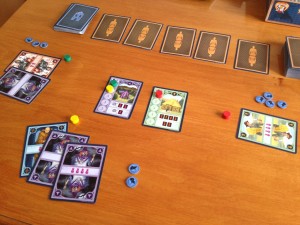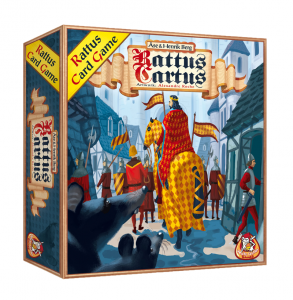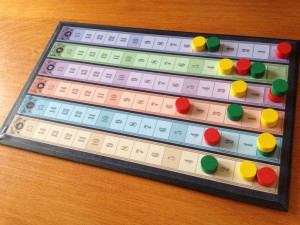Review: Rattus Cartus
Posted by James (admin) on May 31st, 2013
 Rattus Cartus is a card game set in the world of medieval plague as is its sibling game, Rattus. It should make it clear that Rattus Cartus is not a card game version of the original Rattus game as, whilst is uses the same theme and art style, it has its own game mechanics.
Rattus Cartus is a card game set in the world of medieval plague as is its sibling game, Rattus. It should make it clear that Rattus Cartus is not a card game version of the original Rattus game as, whilst is uses the same theme and art style, it has its own game mechanics.
The goal is to earn the most victory points (VPs). At the end of the game, players score VPs based on how much influence they have with each of the 6 different character classes (10 VPs for having the most, 5Vps for 2nd most, and 2 VPs for third most influence). Some other VPs can be earned during the game too.
The game primarily comprises of character cards (6 types) and building cards (6 types each corresponding to a character). During set-up 5 random character cards are laid out face-down – each card has 0-4 nuns on it – and these are called the ‘nun’ cards. At the end of the game, any player who has more rats than the total number of nuns on these 5 cards is lost to the plague and automatically loses.
Each round, 3 building cards (2 in a 2- or 3-player game) are drawn and laid out. Then, players simultaneously choose one building from which they will gain its benefit which can be a mix of drawing character cards, discarding rats, or looking at nun cards.
Next, going clockwise from the start player (and regardless of which building they just benefited from), players place their coloured playing piece on the lowest numbered space of one of the buildings and announces how many character cards they will play from their hand (placing those cards in front of them, but without revealing them).
Once all players have done this, the buildings are resolved in order and one at a time. All players in a building reveal the cards they played. For each character card played (regardless of the type), a player gains 1 influence of the type matching the building. However, for each character card that did not match the building’s type, the player gains 1 rat. Finally, the player who played the most cards (regardless of type) gets to execute the building’s premium action (in the case of a tie, it’s the player who placed their token on the building first), whilst any other players at the building get to perform the building’s standard action. These actions include things like gaining VPs, discarding rat tokens, gain special cards (like jokers and pass cards), looking at nun cards, gaining character cards, etc.
After 8-10 rounds (depending on the number of players), the game ends and players add up their VPs. However, at this point, the 5 nun cards are revealed and players now discover (if they haven’t already got to see them during the game) if they automatically lose by having more rats than nuns.
 Overall, Rattus Cartus is a fun and quick game of balancing tricky decisions. As the game only lasts 8-10 rounds, it can be over well before you’re ready for it to end. Do you play lots of cards to gain influence and (hopefully) use the building’s primary action but at the cost of gaining rats if your cards don’t match? How many cards will players still to play lay down? Is using the action of one building worth it the influence gained from it won’t benefit you? Do you spend time to view all the nun cards at the expense of doing other actions?
Overall, Rattus Cartus is a fun and quick game of balancing tricky decisions. As the game only lasts 8-10 rounds, it can be over well before you’re ready for it to end. Do you play lots of cards to gain influence and (hopefully) use the building’s primary action but at the cost of gaining rats if your cards don’t match? How many cards will players still to play lay down? Is using the action of one building worth it the influence gained from it won’t benefit you? Do you spend time to view all the nun cards at the expense of doing other actions?
I like games where you don’t have enough time to do all that you want to as it forces you to choose and Rattus Cartus definitely does that. Having lots of cards is important as it gives you a better chance to use a buildings’ primary action and to use cards that don’t gain you rats. However, gaining cards is always at the cost of doing other things.
The nun total is a nice game mechanic and adds a real risk to using lots of non-matching cards, so it’s often gaining influence versus gaining rats. Watching what other players who have seen nun cards are doing with regards to their rats can help, but not always. In one of my games, I saw two nun cards totaling 7 so thought I could afford to have some rats, whereas my opponent had seen the other 3 cards which totaled zero nuns! He was being extra cautious with rats so I tried to do the same – I ended with 8 rats as I assumed there would be at least 1 nun on the other 3 cards – wrong! I was over the limit and lost. (Humorously, the next game we played, I was very cautious and used actions to lower my rat total but it cost me in the end as it turned out there were loads of nuns. D’oh!)
Some buildings give players special cards like pass cards (so they can go last in a round) and joker cards (which count as any character type). There are also sword cards which are quite brutal – these are played like a character card and, whilst they don’t earn influence, the player playing the fewest sword cards at the building must give half of their cards to the player who played the most sword cards at the building. Flute cards are similar but let a player pass one of their rats to another player.
In a similar way to the main Rattus game, Rattus Cartus offers variety in each game based on how each game is set-up. There are 2 versions of each of the 6 building types – each version offering different actions. During set-up, players choose to use one version or another of each building type (or they can have a mix of the versions within each type). The different versions and mixture of these versions have a real impact on the game feel.
 The only downside to the game that I can see is that there is some luck of the draw as players who draw character cards that happen to match the building types that appear will not have as many issues with rats because they can play lots of matching cards. However, this is a relatively short and light game, so I don’t mind a bit more luck than I usually would with a larger game.
The only downside to the game that I can see is that there is some luck of the draw as players who draw character cards that happen to match the building types that appear will not have as many issues with rats because they can play lots of matching cards. However, this is a relatively short and light game, so I don’t mind a bit more luck than I usually would with a larger game.
It plays 2-5 players but I think it is most fun with more players as there is more jostling for position in the buildings and more competition on the influence tracks; however, it did still work with 2 players.
In the end, Rattus Cartus is a fun, short, and sometimes brutal, eurogame but with more decisions packed in than you may think. I look forwards to playing it more (and maybe one day actually winning a game).
James.
[Played with 2 and 3 players]
P.S. I have noticed an expansion (Rattus Cartus: Nobilis) is due for release at Essen 2013.

